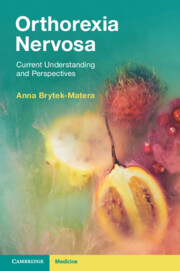Book contents
- Orthorexia Nervosa
- Reviews
- Orthorexia Nervosa
- Copyright page
- Dedication
- Contents
- Foreword
- Preface
- Acknowledgements
- About the Author
- Part I Dieting Trends and Health
- Part II Clinical Description of Orthorexia Nervosa
- 3 Definition of Orthorexia Nervosa
- 4 Diagnostic Overview of Orthorexia Nervosa
- 5 Orthorexia Nervosa and Other Disorders: Differential Diagnosis
- Highlights
- Part III Assessment and Prevalence of Orthorexia Nervosa
- Part IV Multidimensional Characteristics of Orthorexia Nervosa
- Part V Two Decades of Research on Orthorexia Nervosa
- Part VI Future Directions on Orthorexia Nervosa
- References
- Index
5 - Orthorexia Nervosa and Other Disorders: Differential Diagnosis
from Part II - Clinical Description of Orthorexia Nervosa
Published online by Cambridge University Press: 30 October 2024
- Orthorexia Nervosa
- Reviews
- Orthorexia Nervosa
- Copyright page
- Dedication
- Contents
- Foreword
- Preface
- Acknowledgements
- About the Author
- Part I Dieting Trends and Health
- Part II Clinical Description of Orthorexia Nervosa
- 3 Definition of Orthorexia Nervosa
- 4 Diagnostic Overview of Orthorexia Nervosa
- 5 Orthorexia Nervosa and Other Disorders: Differential Diagnosis
- Highlights
- Part III Assessment and Prevalence of Orthorexia Nervosa
- Part IV Multidimensional Characteristics of Orthorexia Nervosa
- Part V Two Decades of Research on Orthorexia Nervosa
- Part VI Future Directions on Orthorexia Nervosa
- References
- Index
Summary
Despite the passage of time, no clear consensus has yet emerged as to whether orthorexia nervosa should be considered (1) as a diagnostic entity that is distinct from established eating disorders and obsessive-compulsive disorder, (2) on the eating disorder spectrum or (3) on the obsessive-compulsive spectrum. Some researchers postulate that orthorexia nervosa should be regarded as a separate eating disorder category (Cosh et al., 2023; Zickgraf et al., 2019), as the moderate effect size observed indicates that orthorexia nervosa and anorexia nervosa are related but still distinct (Zickgraf et al., 2019). While other researchers disagree with the statement that orthorexia nervosa represents a distinct diagnostic entity (associations of orthorexia nervosa with a core of symptoms of eating disorders question the potential of orthorexia nervosa as a distinct diagnosis; Hessler-Kaufmann et al., 2021) and suggest that orthorexia nervosa may instead be an aspect of restrictive eating disorder symptomatology (Meule & Voderholzer, 2021) or a subclinical and asymptomatic form of an eating disorder (Strahler et al., 2018) or a distinct subtype of avoidant/restrictive food intake disorder (Dell’Osso et al., 2016; Moroze et al., 2015) or a new cultural manifestation of anorexia nervosa caused by modern-day diet culture and healthism (Bhattacharya et al., 2022).
- Type
- Chapter
- Information
- Orthorexia NervosaCurrent Understanding and Perspectives, pp. 37 - 52Publisher: Cambridge University PressPrint publication year: 2024

